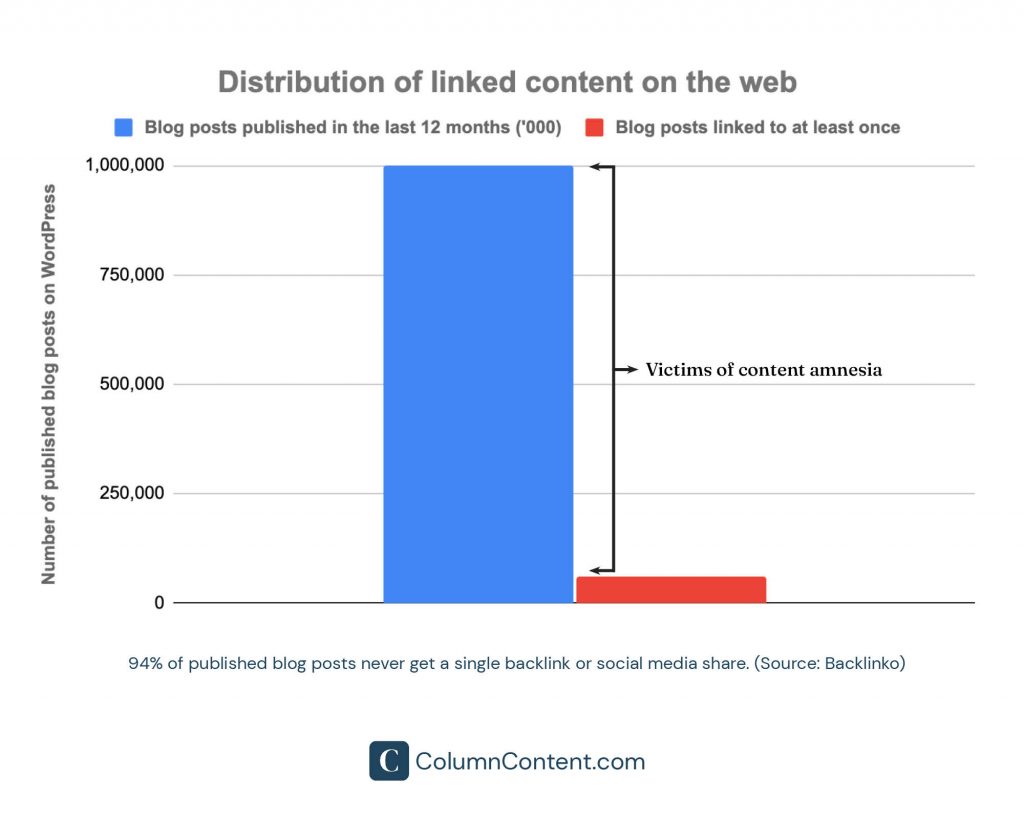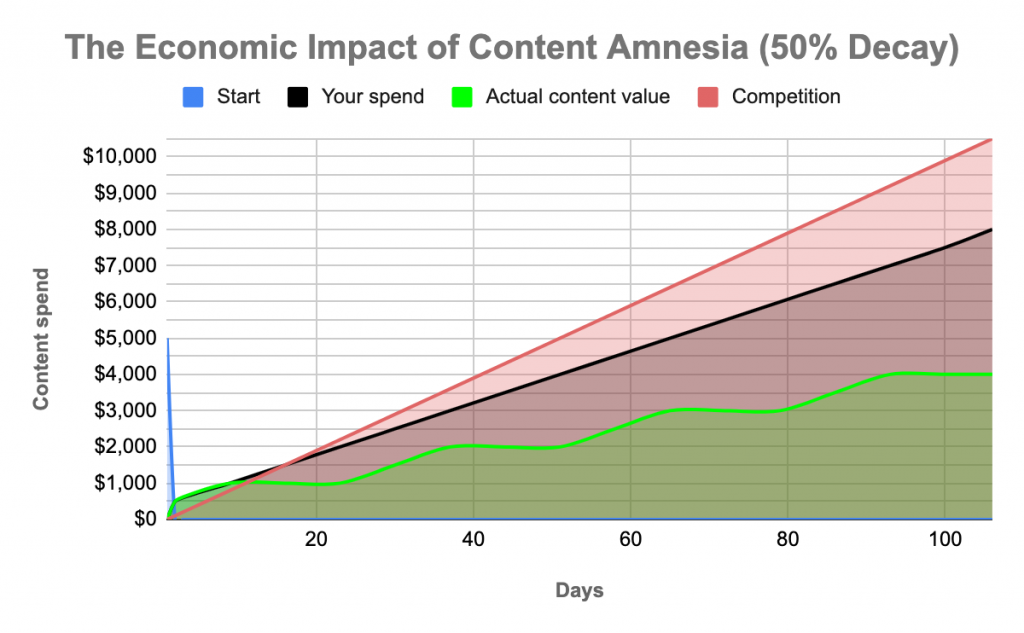What the heck is content amnesia?
The web is awash with forgettable content. In the last year alone, more than one billion blog posts were published, but up to 94% have no external links.

We call this gap “content amnesia” — the tendency of most content to fade into obscurity. As a content strategist, you have only one goal: beating this disease at every turn.
Creating bland content is financially harmful to your content strategy. Here’s the math.
Creating forgettable content has active, long-term, negative effects.
Firstly, your readers feel you’ve wasted their time with bland content.
Secondly, your traffic and revenue grow slower than your peers’ because your efforts are wasted. This lowers your content ROI.
Let’s do some quick math to highlight the financial impact of content amnesia.
Assume you’re entering a new market with a brand-new blog. Pretend each article costs $500, including the hourly research, writing, editing, and design costs.
Let’s further assume that:
- To rank for a specific keyword at the start of your journey, you need ten excellent blog posts.
- Your competitors publish a new competing asset related to that keyword daily.
- Your rankings decrease and you lose $100 in revenue for every new competing asset.
These are extremely conservative numbers. In reality, your target keywords probably have thousands (or millions) of competing articles; dozens more are published each day; and the potential loss is likely far greater (ask those on Page 13 of Google).
Lastly, assume you can only publish one article weekly and that one of every four articles you create is bland (25% decay).
Here’s how our hypothetical scenario plays out:
- At 10 starter articles, you’d need $5,000 just to enter the arena.
- You’re spending $2,000/mo to rank but only getting $1,500 value.
- Every day, $100 (or more) worth of competition enters the arena.
Here’s what the numbers look like over three months:

It takes over two months to meet the 10-article minimum, and you lose content value the entire time.
The above graph assumes you create only one bland content asset out of four each month.
If you’re unaware of content amnesia, you’re likely not checking for it.
You’ll probably keep using cheap writers, weak content research, or AI tools to create content.
This greatly raises your risk of creating more forgettable content.
If two of your four monthly articles are completely forgettable, your total content value drops to half (note how the green line trends at half the content spend):

If left unchecked, the margin between your content marketing investment and ROI widens to infinity. You’re left playing catch-up with a handicap.
Because you start at a disadvantage, dull content consumes time, money, and brand goodwill — and contributes to content fatigue.
Content has no middle ground. You’re either winning or losing.
This is why it doesn’t matter how many content pieces you create each month — what matters is your bland-to-grand ratio.
If you knock it out of the park each time, you’re more likely to create viral content that compounds the value you receive.
Of course, I’m greatly oversimplifying all of this.
We’re presuming other brands create far better content than you every day, you’re limited to four pieces a month and have a limited monthly content budget.
I could be wrong. You might be working with several content agencies, have an unlimited content budget, and play in a niche where everyone else just sucks at content marketing.
But we both know that’s not the case.
The point stands: you’re taking a huge risk by not aiming to create epic content each time.
Content amnesia is a tumor that eats away at your content strategy but is treatable with the right approach.
Let’s now dig into the causes, symptoms, and treatment of content amnesia.

What causes content amnesia?
Churning out forgettable content almost always boils down to one or more of the following:
- Irrelevance: Timely, helpful content sticks out more than old, irrelevant, or non-credible content.
- Frugality: Great writers, editors, designers, and agencies are expensive. If you’re creating the content yourself, your time and tools cost money. Investing in these resources gives you a fighting chance.
- Scale: The more content you produce, the less likely you’ll create good work each time, and the less likely you are to produce quality work and give each piece the attention it deserves. Quality always beats quantity.
- Skill: It’s not enough to hire writers — they must be great writers. An army of mediocre writers accelerates content amnesia.
- Time: Deadlines can make or break content. Make them too tight, and you’ll default to ‘safe’ content, increasing your risk of content amnesia. Make them lax, and content momentum dies.
Content consistency is key.
— Dr Mo (@ShehuPHD) September 2, 2022
Don’t fall off the radar and lose momentum.
Commit to sharing content twice a week.
It gets easier and adds up.
5 symptoms of content amnesia
Your readers can sense boring content a mile away. They’ve developed a sixth sense for time-wasting content. These five symptoms are particularly telling:
- Copycat content structure
- Negative writing patterns
- Unclear focus
- Weak claims
- Poor flow
Let’s dig into each symptom.
1. Copycat content structure
Spend enough time online, and you’ll quickly discern articles written for humans versus those written for search engines.
Keyword stuffing, multiple headings with thin content, and repetition are signs of search engine-optimized articles.
Let’s assume we’re writing an article about workplace communication. A typical SEO intro would be:
“In today’s fast-paced business world, effective workplace communication skills are more important than ever. Whether you’re a manager or an entry-level employee, knowing how to communicate effectively with your colleagues can help you succeed in your career. In this article, we’ll provide ….”
It’s long, wordy, typical, and boring. A sharper blog intro would be:
“Effective workplace communication is crucial for career success today. Not knowing how to talk to your colleagues — whether in the boardroom or over Zoom — can lead to resistance, resentment, and retrenchment. Here’s how to improve your workplace communication skills in as little as 24 hours.”
Shorter, sweeter, and packs a punch.
2. Negative writing patterns
Clichés, jargon, passive voice, repetition, and needless context suck the air out of your writing.
- Clichés like “in the nick of time” and “leave no stone unturned” may come off as lazy and create a communication barrier for second-language speakers.
- Jargon can signal in-group membership, but excessive jargon can be off-putting. For instance, when discussing personal finance, there’s no need to say “amortization” or “APR.” Use “loan payment schedule” or “annual interest rate” instead. Same meanings, simpler words.
- Passive voice dulls your writing. Instead of saying, “the decision was made by the committee,” say, “the committee made the decision” (active voice).
- Repetition lengthens your writing and creates fluff. Say what you must as concisely as possible.
- Needless context buries the lede and increases the risk of losing your reader. Get to the point as quickly as possible.
One skill that will take you far in life (especially in sales and marketing) is being able to write like a knife. Succinctness is underrated, and when you can get to the point in as few words as possible, your readers and customers will thank you for it.
— Dr Mo (@ShehuPHD) February 28, 2021
Hint: Use Twitter more.
3. Unclear focus
You’d struggle to catch six balls thrown at you but could easily catch just one. It’s the same with your content: say one thing to one persona.
Some tell-tale signs of unclear content focus are:
- Trying to rank for several keywords in the same piece (e.g., “CRM for HR” and “CRM for sales”)
- Speaking in the third person (“they”) instead of addressing the reader directly (“you”)
- Meandering between topics without a clear connection
- Failing to make a clear argument or point
- Ignoring the reader’s needs or concerns
- Dumping too much detail at once
Keep your content relevant, interesting, and engaging, and speak directly to your reader.
4. Weak claims
Weak claims can be airy or biased statements. Airy statements lack data, while biased statements aren’t confirmed by anyone else.
An airy statement sounds like, “Most business owners struggle to do their taxes.” (Says who? Which business types? What percentage of owners?)
That’s less effective than “A recent survey of 500 small business owners found that 80% struggled with filing their taxes accurately.”Similarly, a biased statement like “Our CRM is the best on the market” is less effective than one backed by data, such as “Our CRM has been rated 9 out of 10 on G2.”
5. Poor flow
Flow can help or harm the reading experience. Content amnesia can crop up when there is:
- No clear structure (e.g., not enough headlines)
- Poor paragraph flow (no segues or callbacks)
- Poor grammar (typos and weak punctuation)
Flow takes practice to master and can be overlooked if you never read your work aloud.

7 ways to fix forgettable content and cure content amnesia
First, start with a content audit.
Note the cadence and type of content you create and the audience response.
You can measure content resonance by the number of impressions and views you get (relative to your audience size), whether your content gets mentioned on sales calls or conversations, and whether it gets widely shared.
It’s not always about likes.
With this information, apply the following seven fixes to existing and future content:
- Write timely and relevant content
- Promote content exhaustively
- Reference more experts
- Extend your timelines
- Sharpen your editing
- Break a few patterns
- Add credible data
Here’s a quick look at each one.
1. Write timely and relevant content
You could apply this fix alone and be forgiven for every other mistake.
Your audience deals with specific problems, and you’ll only earn their attention by publishing content that solves them.
You can unearth these content topics through market research, customer interviews, and community immersion.
Keyword research tools are great, but they provide only part of the story (and even then, it’s usually incomplete, as ‘zero-search-volume‘ keywords can still be valuable to your business).
To find keywords that drive traffic and conversions, combine your customer’s Jobs-To-Be-Done with your product’s unique value prop.
2. Promote content exhaustively
You can overcome content amnesia with better content distribution. For example, after publishing your content, you can:
- Share it on social media at least five times (schedule the posts using Publer)
- Share it to groups on Slack, Facebook, LinkedIn, and Reddit
- Create a two-minute video summary
- Shorten it for your newsletter
- Repurpose it into a podcast
- Run a few ads against it
- Generate a quiz from it
Extensive promotion can add more value to your content. Check out this piece on content promotion tactics for 30 more tips you can use.
You don't always need to write new content.
— Dr Mo (@ShehuPHD) September 22, 2022
You can take a popular concept and:
– Create a game around it
– Host an event around it
– Write a poem about it
– Film a sketch about it
– Animate it
– Narrate it
– Record it
– Draw it
– Paint it
– Sing it
The ideas are endless.
3. Reference more experts
Eliminate biased claims by referencing credible third parties. Readers expect you to promote yourself, so they’re more likely to trust those sources.
Do content interviews and surveys as you craft each piece — even if it’s just asking experts via LinkedIn to share their thoughts.
I often ask my Slack and LinkedIn network to contribute quotes to published pieces.
For instance, this career guide for new marketing leaders was sourced entirely from the marketing VPs in my LinkedIn network.
If you’re a new marketing leader, you might not believe my advice, but you’d readily believe theirs.
4. Extend your timelines
Good content needs enough pressure to get it done and enough time to get it done right.
Depending on your content strategy and resources, you might need to extend your content publishing timelines, hire more writers, or hire an agency.
Alternatively, adjust your content strategy and timelines to align with your goals and resources. Use tools like Asana to track your content pipeline.
5. Sharpen your editing
Good content is 5% writing and 95% editing. Here are seven ways to sharpen your editing:
- Avoid passive voice: Passive voice dulls your writing and makes it wordier. Use an active voice.
- Be consistent: Use the same style, tone, and formatting to improve content consumption.
- Remove needless words: Removing fluff makes your writing clearer and more concise.
- Take breaks: Taking time between writing and editing helps you spot mistakes better.
- Use editing tools: Grammarly and Hemingway can help you catch writing errors.
- Get feedback: Ask others to critique your writing and help you find blind spots.
- Read out loud: You can catch errors and awkward phrasing better.
6. Break a few patterns
If your content always follows the same structure or format, try switching it up to beat content amnesia.
For example, instead of starting with a matter-of-fact blog intro, start with a story or surprising fact to grab and hold your reader’s attention.
If you’re used to writing long-form blog posts, try publishing content as a podcast episode or newsletter. Skip the LinkedIn posts once a week and try polls or carousels.
Test new formats to see what works, then double down on the winners.
7. Add credible data
Only 22% of content marketers surveyed said they use fact-checking procedures or tools. This is a big problem in a profession that wants to build audience trust and credibility.
Adding data to your content makes it more credible, but it must be credible — not old stats pulled out of ancient reports to bolster a specific point.
Solid references also help you meet Google’s ranking criteria for experience, expertise, authoritativeness, and trustworthiness (E-E-A-T).
Back up your claims with data and illustrate them with charts or graphs where possible.
Beat content amnesia today
All content starts out losing the race by default. And if you’re not doing everything you can to help it win, you might as well light your money on fire.
Content amnesia hurts you and your readers. It wastes time, resources, and hampers growth.
Create content your audience will remember and share with their networks.





